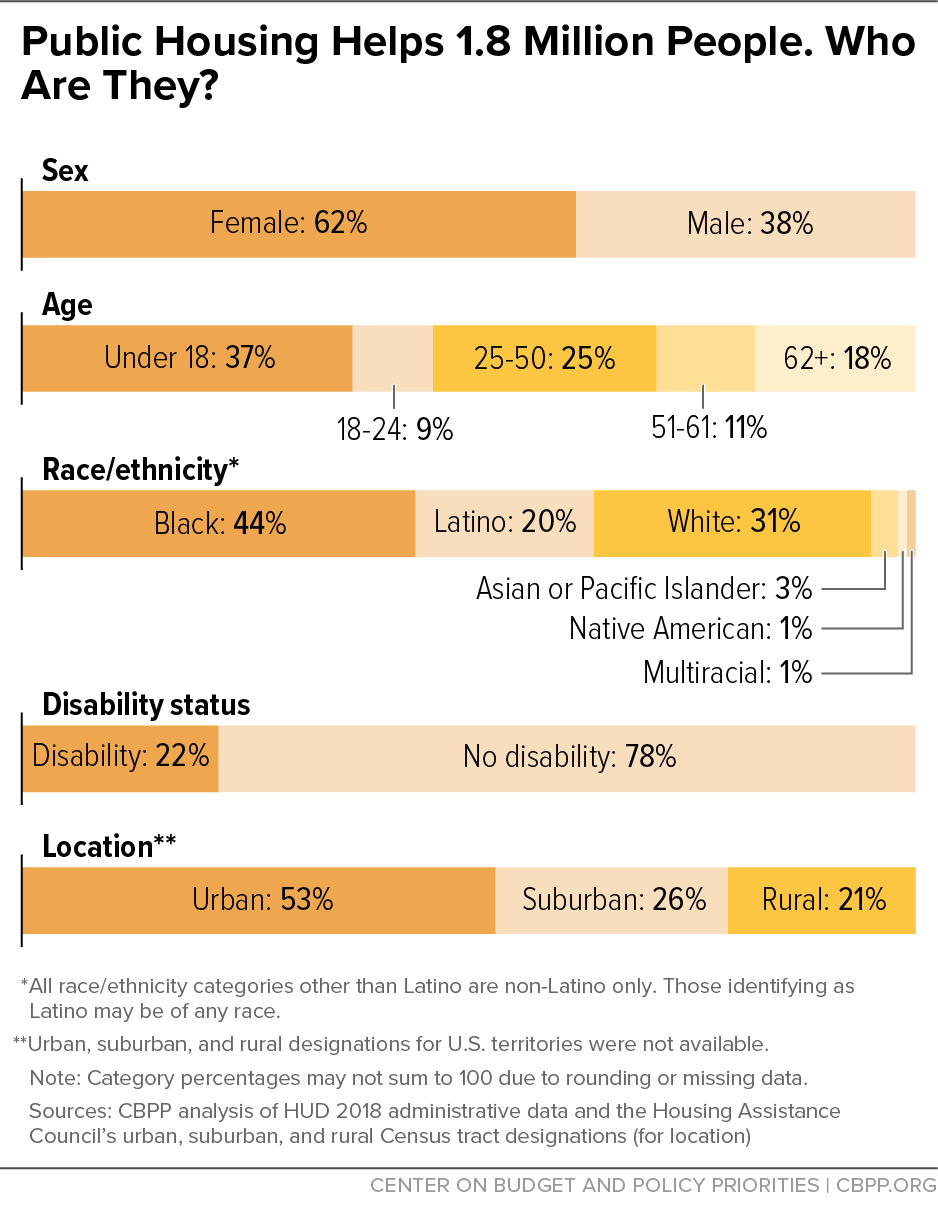- Home
- Public Housing
Policy Basics: Public Housing
Public housing is one of the nation’s three main rental assistance programs, along with Housing Choice Vouchers and Project-Based Rental Assistance. Public housing developments provide affordable homes to 1.8 million low-income Americans.
Where Is Public Housing Located?
The nation’s 958,000 public housing units are located in all 50 states and several territories, with 1 in 5 of them in rural areas. As of 2019, only 47 percent of public housing homes were in low- or moderate-poverty areas, or where less than 30 percent of people had low incomes. Public housing is concentrated in racially segregated, under-resourced neighborhoods, due in part to a long history of racial bias in siting decisions and other discriminatory public policies.
What Are the Benefits of Public Housing?
Public housing helps families afford housing and avoid homelessness or other kinds of housing instability. Some developments provide access to neighborhoods with well-resourced schools and more job opportunities, where it might otherwise be difficult for low-income families to rent homes. By limiting housing costs, public housing leaves families with more resources for other expenses like food, health-related services, child care, and transportation. Public housing can also allow older adults and people with disabilities to remain in their home communities.
Who Is Eligible for Public Housing?
A family must have a “low income” — defined as less than 80 percent of the local median income — in order to move into public housing. At least 40 percent of the new families that a housing agency admits each year must have “extremely low incomes” that are no greater than 30 percent of the local median or the poverty line, whichever is higher; on average, agencies exceed this requirement by a large margin.
Families with an immigrant whose status makes them ineligible for public housing can receive prorated assistance based on the number of household members who are eligible.
In 2020, 56 percent of public housing households were headed by older adults or people with disabilities. Among other households, a great majority included a working adult or an adult who worked recently. The majority of people living in public housing are Black or Latino. More than one-third of all residents are children under age 18.
How Much Do Public Housing Tenants Pay for Rent?
Most tenants pay 30 percent of their income (after certain deductions are taken out) for rent and utilities. Housing agencies can choose to require families to pay a minimum rent of up to $50 even if this is more than 30 percent of their income, and families can opt to pay a flat rent based on local market rents regardless of their income.
How Is Public Housing Funded?
The federal government funds public housing through two main streams: (1) the Public Housing Operating Fund, which is intended to cover the gap between the rents that public housing tenants pay and the developments’ operating costs (such as maintenance and security); and (2) the Public Housing Capital Fund, which funds renovation of developments and replacement of items such as appliances and heating and cooling equipment.
Both streams have long been deeply underfunded. In all but three years since 2000, the federal government has provided less funding than agencies were due under the operating fund, triggering pro rata cuts to each agency’s funding. Inadequate capital funding has contributed to a backlog of unmet renovation needs. The most recent national assessment in 2010 estimated the backlog of unmet needs at $26 billion, but it excluded major categories of costs, and other data indicate that the need is likely considerably higher. For example, a 2017 assessment found that the New York City Housing Authority, which administers 17 percent of the nation’s public housing, faced $32 billion in capital needs over five years.
In addition, the Choice Neighborhoods Initiative (which Congress first funded in 2010 and has replaced the similar HOPE VI program) provides a small number of grants each year to revitalize distressed public housing developments. No funds have been provided to build additional public housing since the mid-1990s.
Why Has the Number of Public Housing Units Declined Over Time?
The number of public housing units has fallen by more than 200,000 since the mid-1990s as housing agencies have demolished or removed units from the stock because of deterioration resulting from long-term underfunding and other factors. Only a small share of the removed units has been replaced with new public housing.
In addition, since 2012 housing agencies have converted more than 140,000 public housing units to long-term Section 8 Project-Based Voucher and Project-Based Rental Assistance contracts under the Rental Assistance Demonstration (RAD). RAD is designed to provide more reliable funding and make it easier to attract private financing to address rehabilitation needs. HUD can permit up to 455,000 public housing units to be converted under RAD, and more than half of the limit have already been converted or are in the pipeline.
Who Owns and Manages Public Housing?
While the Department of Housing and Urban Development (HUD) oversees the public housing program, it is administered locally by about 2,830 public housing agencies. Most agencies own and manage the public housing developments themselves, but some contract with private management companies or transfer ownership to a private subsidiary or another entity that operates the development under public housing rules.
The Center on Budget and Policy Priorities is a nonprofit, nonpartisan research organization and policy institute that conducts research and analysis on a range of government policies and programs. It is supported primarily by foundation grants.
